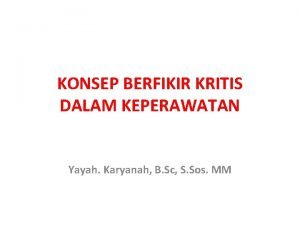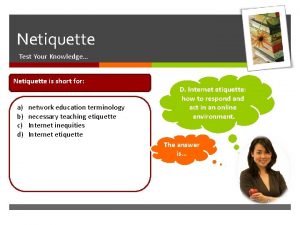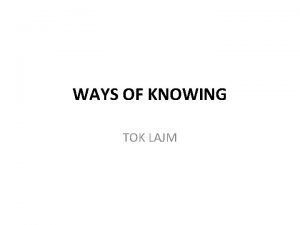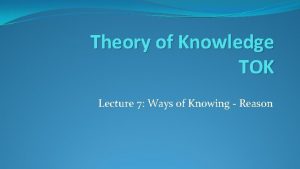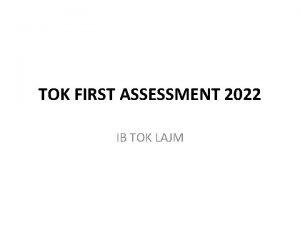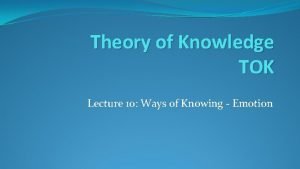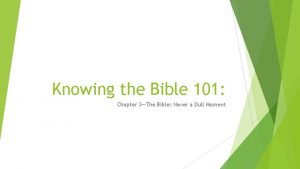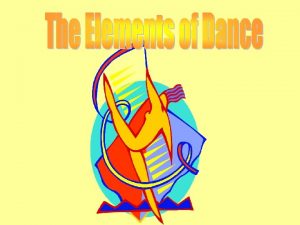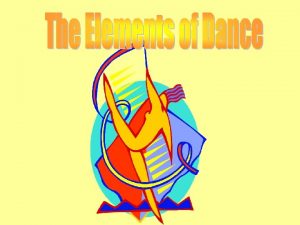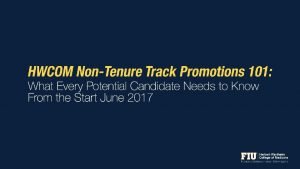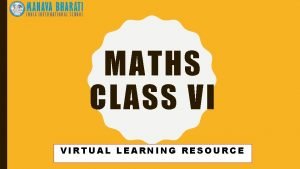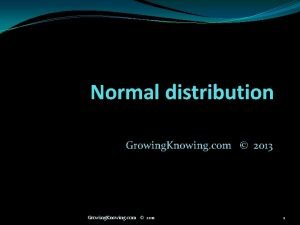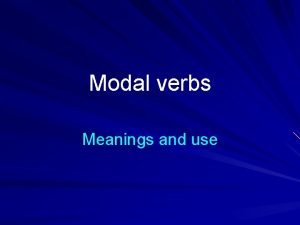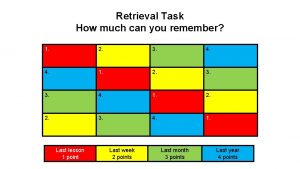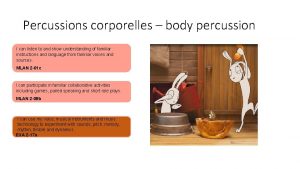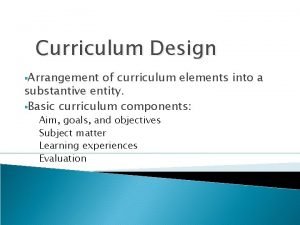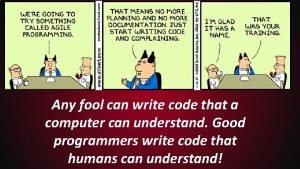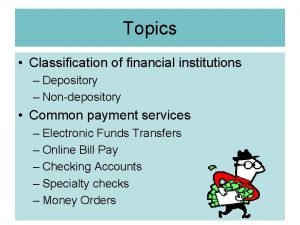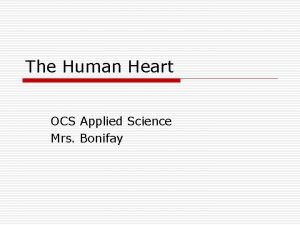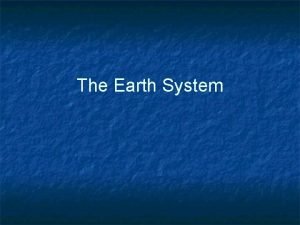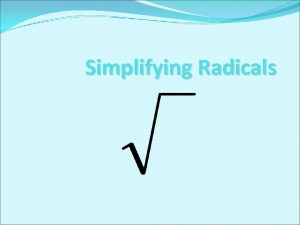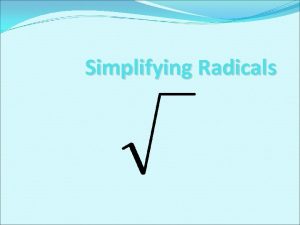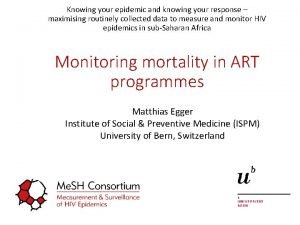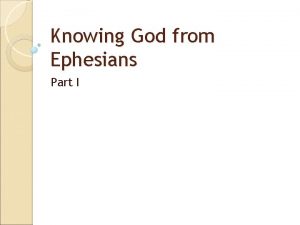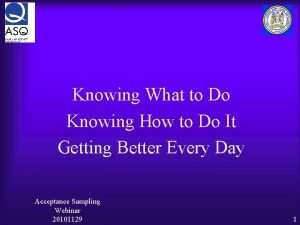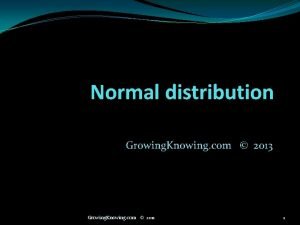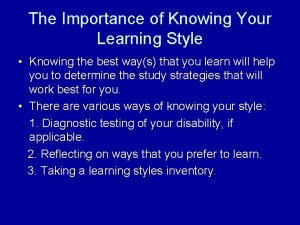Knowing what you can do So you can


























































































- Slides: 90

Knowing what you can do, So you can know what you should do.

Contact Information Dave Vick dave@vickassociates. com 480 -758 -4582 8700 E Vista Bonita Drive Suite 240 Scottsdale, AZ 85255

Disclaimer Maximizing Social Security Workshop is an educational program, and is not intended to sell investment or insurance products, nor is it intended to provide tax or legal advice. Consult with your tax advisor and/or legal counsel for suitability for your specific situation. This presentation is not endorsed or approved by the Social Security Office or any other Government Agency. Hypothetical and/or actual historical returns contained in this presentation are for informational purposes only and are not intended to be an offer, solicitation, or recommendation. Rates of return are not guaranteed and are for illustrative purposes only. Projected rates do not reflect the actual or expected performance within any example or financial product.

Course Introduction • Participation and Questions are good • Class is from 9: 30 pm to 11: 30 + • One hour strategy session. • Course materials: Maximizing Social Security Workbook. • Fill out Workshop Goals sheet.

Who is Your Instructor? • Financial Planner for 25 years • NSSA Certified • Author & Speaker • Husband to Diane • Father to Tom & his wife Abby • Gampy to Nora • Cardinals Fan!

Important Information for 2019

5 FRA – Full Retirement Age • FRA - Full Retirement Age or Normal Retirement Age age eligible to receive full or unreduced benefits. • Benefits as early as age 62 and as late as age 70. • Born after 1937, FRA later than age 65 • Born after 1937, greater reduction in benefits taken before Full Retirement Age To Receive Full Social Security Benefits (FRA) 1937 or earlier 1938 1939 1940 1941 1942 1943 to 1954 1955 1956 1957 1958 1959 1960 and later https: //www. socialsecurity. gov/planners/retire/agereduction. html 65 65 and 2 months 65 and 4 months 65 and 6 months 65 and 8 months 65 and 10 months 66 66 and 2 months 66 and 4 months 66 and 6 months 66 and 8 months 66 and 10 months 67

5 Social Security - By the Numbers • 1935 - August 14, President Franklin D. Roosevelt signed into law the Social Security Act. • 1937 – Taxes (Federal Insurance Contributions Act or FICA) were started to be collected for the Social Security Act. http: //www. ssa. gov/history/hfaq. html

5 Social Security - By the Numbers • 1940 - Regular monthly benefit payments began. • 1956 – Disability benefits were added. • 1972 – Cost of Living Adjustments (COLA) were written into the code and first pay in 1975. • 453. 7 million – Social Security numbers issued since November 1936, with an add-rate of 5. 5 million per year http: //www. ssa. gov/history/hfaq. html https: //en. wikipedia. org/wiki/Social_Security_number 6

6 Social Security - By the Numbers • 222, 488 – Number of Americans receiving Social Security benefits in 1940, less than 1% of the total population. • 62 million – Number of those receiving Social Security Benefits in 2017, about 20% of the total population. * • $22. 71 – The average monthly benefit for a retired worker in 1940. • $1, 461 – The average monthly benefit for a retired worker in January 2019* *Source: SSA. gov

5 Social Security - By the Numbers • 159 to 1 The ratio of workers paying into the system for every beneficiary in 1940. • 2. 8 to 1 The ratio of workers paying into the system for every beneficiary in 2017. • 2. 2 to 1 The ratio of workers estimated to be paying into the system for every beneficiary in 2035. • 2034 The year it is estimated that the Social Security Trust Fund will run out of money. https: //www. ssa. gov/history/ratios. html https: //www. ssa. gov/news/press/factsheets/basicfact-alt. pdf

6 Yesterday & Today OASDI Old Age, Survivor, and Disability Insurance The OASDI provides retirement benefits when someone retires, or benefits to survivors when someone passes away who has paid into the OASDI fund, or benefits to someone who becomes disabled.

6 Yesterday & Today • First monthly check to Ida May Fuller, January 1940, then 65, of Ludlow, Vermont for the amount of $22. 54. • She received her first increase in benefits in 1950. • She passed away in 1975 at age 100.

7 Benefits Tied to Your Work Record • Qualifying based on “credits” earned. • Maximum of four “credits” each year. • One credit = $1, 360 – $5, 440 = 4 credits in 1 year • Earned income only. • Need a minimum of 40 credits. – 10 years of work

Do You Remember This Family? • Ward earned credits while working and June stayed home with Wally and the Beaver.

8 Benefits for Spouses • A nonworking spouse will receive 50% of their spouse’s FRA benefit if they apply at FRA • At age 62, their benefit is reduced by as much as 30% depending on their FRA • Spousal benefits are gender neutral • Spousal benefits don’t earn delayed credits

June’s Spousal Benefits (Assuming June worked outside the home) • Example: Ward is 66, retires and claims his benefits ($2, 400/Month). • June, 62 decides to claim her benefits, also. • June’s own benefit at FRA is $1000/month. – $750/month at 62 (25% reduction)

June’s Spousal Benefits (Assuming June actually worked outside the home) Ward’s PIA $2, 400 50% of Ward’s PIA $1, 200 June’s PIA $1, 000 Spousal Add-On $200 June’s Spousal Add-on receives a 30% reduction and is $140 • June’s own PIA of $1, 000 is reduced by 25% and is $750 • • •

June’s Spousal Benefits (Assuming June actually worked outside the home) • June’s Own Benefit • June’s Spousal Benefit • June’s total benefits $750 $140 $890

June’s Spousal Only Benefits (if she turned 62 by 1/1/16 and currently FRA) • If she waits until FRA, June can select her spousal benefits, and let her own benefits build delayed credits. Also, Ward would have to be receiving his benefits. • June’s Spousal Only Benefit = $1, 200 (1/2 Wards PIA) • June’s own benefit = $1, 000 • June elects the spousal only benefit (restricted application) and lets her $1, 000 earn delayed retirement credits. • June’s benefit at age 70 is at least $1, 320

Qualifying for Social Security Benefits for divorced spouses

9 Benefits for divorced spouses • Benefits are paid to a divorced spouse if he/she is: – Currently single – At least age 62 – Had been married at least 10 continuous years. – Worker (ex-spouse) is receiving a retirement or disability benefit if divorced for less than 2 years – If divorced for at least 2 years, the worker does not have to be receiving a SS benefit

Benefits for divorced spouses (Restricted Application) • If the divorced spouse was born by January 1, 1954, he/she can file can only for a spousal benefit at Full Retirement Age, (Restricted Application), allowing own benefit to grow and earn Delayed Retirement Credits. This will result in: • Receiving the divorced spouse benefits from ages 66 to 70, • Letting her own benefit receive delayed credits until age 70. 9

It could happen, right? Ward and June divorced after Beaver was caught shoplifting at Kmart. – She’s 62 & currently unmarried. – June & Ward were married for 20 years. – Ward is 66, but delaying benefits until age 70. What could June do?

Qualifying for Social Security Benefits for widows and widowers

10 Benefits for widows and widowers • A spouse may switch to her husband’s higher benefit at his death or vice versa. • Survivor benefit will be based on the high earning husband’s benefits – Including any delayed credits. • The husband need not have already applied for the widow to receive the higher benefit.

10 Benefits for widows and widowers • A widowed spouse may claim benefits as early as age 60, or 50 if they are disabled. • Reduction for receiving benefits early will apply.

10 Benefits for widows and widowers • If a widow remarries before claiming at age 60, the survivor benefit is disallowed, unless that marriage ends. • If a widow was married at least ten years and their spouse dies, whether they were still married or divorced at the time of the death, they may be entitled to a survivor benefit.

Ward Passed Away, and June… • June remarried at age 55 to Ted, Ward’s golfing buddy. • She went in to claim benefits at age 60, based on Ward, but was disallowed because of her marriage to Ted! • So, June promptly divorced Ted and claimed her Survivor’s benefits and now lives on a golf course with the Beav, (who owns the course).

10 Benefits for widows and widowers • Widows and widowers who qualify for benefits based on their own work credits may want to take advantage of delayed credits on their benefits until age 70 while receiving survivor benefits at age 60. • Earnings Test still applies prior to full retirement age.

11 Working while you receive benefits • Until you reach full retirement month, working may reduce your benefit amount. • Once you reach FRA your benefits are recalculated so you now receive additional • Only earned income counts.

Formula for Determining Benefits While Working Before FRA: • Deduct $1 of benefits for every $2 you earn above of $17, 640 in 2019. In the year you reach FRA: • Deduct $1 in benefits for every $3 you earn above $46, 920 in 2019. – only count earnings before the month you reach FRA. • No limit on your earnings starting with the month you reach FRA. Source: SSA. gov 11

Working while you receive benefits • Ward, 62, receives $1, 200 in SS benefits and decides to work part time at the golf course earning $18, 320/year. $18, 320 - $17, 640 $1, 280 $ 680 Lost SS Benefit at age 62 • Ward would not receive a benefit for the first month and then in the second month begin benefits. Source: SSA. gov

Calculating Your Retirement Benefits

12 FRA – Full Retirement Age • FRA - Full Retirement Age or Normal Retirement Age age first eligible to receive full or unreduced benefits. • Benefits as early as age 62 and as late as age 70. • Born after 1937, FRA later than age 65 • Born after 1937, greater reduction in benefits taken before Full Retirement Age To Receive Full Social Security Benefits (FRA) 1937 or earlier 65 1938 65 and 2 months 1939 65 and 4 months 1940 65 and 6 months 1941 65 and 8 months 1942 65 and 10 months 1943 to 1954 66 1955 66 and 2 months 1956 66 and 4 months 1957 66 and 6 months 1958 66 and 8 months 1959 66 and 10 months 1960 and later 67

12 FRA – Full Retirement Age • PIA: Primary Insurance Amount • Tally each year’s earning on which Social Security taxes were paid and apply an index factor to each year. • Total your 35 highest indexed earnings years

13 Maximum Taxable Earnings • Both self-employed income and regular wages that are covered by Social Security are subject to taxes each year up to a maximum amount. • (note increases!) 2006 $94, 2007 $97500 2008 $102, 000 2009 $106, 800 2010 $106, 800 2011 $106, 800 2012 $110, 100 2013 $113, 700 2014 $117, 000 2015 & 2016 $118, 500 2017 $127, 200 2018 $128, 400 2019 $132, 900

How to Find Your Social Security Benefit Amount

Using Your Online Statement to Estimate Benefits • The “My Social Security” online account system will provide your personal Social Security Statement. • Go to www. socialsecurity. gov/myaccount and click on Create an Account 14

Taking Benefits Before Full Retirement Age A very common and a very expensive mistake !

The Beaver’s Benefits • • • Beaver born in 1943 His FRA is 66 Let’s say his benefits at FRA is $2, 500/Month Age 62 benefits = $1, 875/Month Beav’s wife’s spousal benefit at age 62 is $875/Month

Break-Even Points $29, 604 $30, 408 $29, 604 $60, 012 $91, 236 $123, 303 $156, 236 $190, 058 2$224, 793 $260, 466 $297, 102 $334, 728 $373, 370 $413, 055 $453, 811 $495, 668 $538, 655 $582, 803 $628, 143 $674, 707 $722, 528 $771, 640 $822, 078 $873, 878 16

17 Surviving Spouse Considerations Life Expectancy Age 84 Benefits claimed at age 62: • $2, 211/month • $25, 532/year Benefits claimed at age 66 & 4 months: • $2, 949/month • $35, 388/year 33% more benefits than age 62 Benefits claimed at age 70: • $3, 893/month • $46, 716/year 76% more benefits than age 62 https: //www. socialsecurity. gov/OACT/quickcalc/

How COLAs Affect Benefits • Cost of Living Allowances - COLA • Designed to keep up with inflation. • COLAs announced in October - affects benefits starting in January. – COLA for 2018 is 2%. • COLAs are tied to the CPI-W • For long term planning the Social Security Trustees use the inflation rate of 2. 7% https: //www. ssa. gov/news/press/factsheets/colafacts 2018. pdf 18

Below is a graph showing the increases in Social Security benefits from 1950 to 2018. (18 Social Security Benefit Increases 1950 -2018 Effective Date Percent Increase Sep-50 77. 00% Dec-92 3. 00% Sep-52 12. 50% Dec-93 2. 30% Jan-65 7. 00% Dec-94 2. 80% Feb-68 13. 00% Dec-95 2. 60% Jan-70 15. 00% Dec-96 2. 90% Jan-71 10. 00% Dec-97 2. 10% Sep-72 20. 00% Dec-98 1. 30% Mar-74 7. 00% Dec-99 2. 50% Jun-74 11. 00% Dec-00 3. 50% Jun-75 8. 00% Dec-01 2. 60% Jun-76 6. 40% Dec-02 1. 40% Jun-77 5. 90% Dec-03 2. 10% Jun-78 6. 50% Dec-04 2. 70% Jun-79 9. 90% Dec-05 4. 10% Jun-80 14. 30% Dec-06 3. 30% Jun-81 11. 20% Dec-07 2. 30% Jun-82 7. 40% Dec-08 5. 80% Dec-83 3. 50% Dec-09 None Dec-84 3. 50% Dec-10 None Dec-85 3. 10% Dec-11 3. 60% Dec-86 1. 30% Dec-12 1. 70% Dec-87 4. 20% Dec-13 1. 70% Dec-88 4. 00% Dec-14 1. 50% Dec-89 4. 70% Dec-15 Dec-90 5. 40% Dec-16 Dec-91 3. 70% Dec-17 2. 0% Dec-18 2. 8% 1. 70%. 30%

20 Taxation of Benefits • Provisional Income – Provisional Income is used to determine whether you will pay taxes on your Social Security benefits. – How to Compute PI: Adjusted Gross Income Before SS Benefit+ municipal interest income= Modified Adjusted Gross Income (MAGI) + half of SS Benefits= Provisional Income (PI)

20 Taxation of Benefits Filing Status Provisional Income Married filing jointly Under $32, 000 to $44, 000 Over $44, 000 Amount of Social Security benefits subject to tax 0% 50% 85% Single, head of household, widower, married filing separately and living apart from spouse Married filing separately and living with spouse Under $25, 000 to $34, 000 Over $34, 000 0% 50% 85% Over $0 85%

Windfall Elimination Provision & Government Pension Offset

21 Windfall Elimination Provision - WEP • If you receive a pension from a non-Social Security covered job, your Social Security benefit may be reduced. • The longer you work in the Social Security covered job, the reduction might be less. • No WEP reduction if in a Social Security covered job for more than 30 years with substantial earnings.

Ward Worked for the CIA! • Ward worked as an “analyst” for the CIA for 20 years, and then 30 years at a local bookstore. – He receives a Federal pension – Plus full SS Benefits!

23 Medicare & Social Security • Medicare begins at age 65, • If receiving benefits at age 65 from Social Security you will automatically be enrolled. – If not receiving Social Security at age 65, you will not be automatically enrolled. • If delaying benefits, enroll in Medicare three months before your 65 th birthday. – Penalty on your Part B premium for failure to enroll within 4 months after your 65 th birthday. – Exception to rule: still working and have insurance coverage through your employer’s plan or by a spouse’s group plan.

22 Medicare & Social Security • Medicare is not free and does not cover all your healthcare costs. • Deductibles and copayments for hospital, doctors’ visits, prescription drugs. • Medicare has a very limited amount of nursing home benefits. • CRITICAL to have Medicare Supplement in the coming future.

The Future of Social Security: Solvency Issues and Reform Proposals

23 Solvency Issues • Social Security is not like a 401(k) or IRA in which your funds are put on deposit for your retirement. • It is a government run insurance program in which current wage earners support those receiving benefits in retirement.

23 2017 OASDI Trustees Report • Medicare and Social Security accounted for 42% of federal program expenditures for 2016. • The OASDI trust fund currently holds about $2. 8 trillion • Social Security’s total expenditures exceeded the amount of funds coming in through taxes since 2010. • The deficit is being covered by interest income from treasury securities https: //www. ssa. gov/oact/trsum/

23 2018 OASDI Trustees Report • After 2021, the Treasury will start to redeem trust fund asset reserves to pay for expenditures over the tax income and interest income • Predicts the total depletion of trust fund assets in 2034 • Tax income will be able to cover about 79% of scheduled benefits through 2091 https: //www. ssa. gov/oact/trsum/

24 Social Security Message to the Public “Lawmakers should address the financial challenges facing Social Security and Medicare as soon as possible. Taking action sooner rather than later will permit consideration of a broader range of solutions and provide more time to phase in changes so that the public has adequate time to prepare. ”

24 Social Security Reform Social Security reforms may include: • Raising pay-roll taxes on high-income workers • Raising the retirement age • Revising the formulas for future benefits You should not make decisions like delaying benefits based on the fear of Social Security going bankrupt.

25 Maximizing Your Benefits • Delay claiming until later while using your qualified accounts first. • Social Security gains a guaranteed 8% per year in delayed credits. • Couple your Social Security benefits and withdrawals from your non-qualified investments at age 70. • Get competent – experienced help FIRST!

25 Factors to Consider When Claiming Factors to consider: • Your retirement goals • Current health • Family health history • Retirement assets such as 401 k and IRA accounts • Factors which will impact your longevity, needs and budget

26 Do you know how ALL your assets fit together with your SSB to fund your quality of life in retirement? DAY, DATE, TIME LOCATION

26 The Equation is Simple SSB + OIS = RI • SSB (Social Security Benefits) • OIS (Other Income Sources) • RI (Retirement Income)

26 The Equation is Simple SSB + OIS(PI+AI+WDI+DI+II+RMD) = RI • PI (Pension Income) • AI (Annuity Income) • WDI (Withdrawal Income) • DI (Dividend Income) • II (Interest Income) • RMD (Required Minimum Distributions)

26 The Equation is Simple …and then there’s taxation (SSB-TOB) + (OIS*NET) = RI • TOB (Tax On Benefits) • NET (Net Effective Tax)

27 Still, it’s a Simple Equation SSB + OIS = RI Or is it?

27 What’s Not Simple? When? How? Why?

27 What’s Not Simple? When? Age 62? FRA? Age 70? Spouse?

27 What’s Not Simple? How? Which assets to use first? Percent of guaranteed income? Percent of income from Market assets? Withdrawals? RMDs? Working after retirement?

27 What’s Not Simple? Why? Funding a budget? Or funding a quality of life in retirement?

27 What does your dream retirement look like? Let’s make a list:

Do you know how ALL your assets fit together with your SSB to fund your quality of life in retirement? DAY, DATE, TIME LOCATION

Do you know how to “Bridge the Gap”

Challenges to Creating Retirement Income 1. 2. 3. 4. 5. 6. 7. 8. Life expectancy Inadequate savings Inflation Taxation Uncertainty in the markets Rising healthcare costs Unrealistic expectations Bad Advice 28

29 Six Pillars of Retirement Income 1. Pre-tax or qualified retirement accounts 2. Defined Benefit Plans: corporate pension plans 3. Defined Benefit Plans: personal pension plans 4. After-tax or “non-qualified” savings 5. Tax-free accounts 6. Social Security and Medicare

30 The key to successful retirement planning is determining the balance of guarantees and risk.

What Percent of Retirement Income Do You Want Guaranteed? We suggest you ABC your portfolio. 30

“The 4 Percent Rule is Not Safe in a Low-Yield World” Michael S. Finke, Professor, Texas Tech University Lubbock, Texas 4%

31 -33 Low Yield • • • Taxable Liquid Bank CDs Savings Checking 10% Low to Mod • Tax-Deferred • Moderately Liquid 30% Growth • • • Taxable Liquid 401 k IRA’s Stock/Bond 60%

32 Three Green Money Rules • Rule #1: Protect Your Principal • Rule #2: Protect Your Gains • Rule #3: Protect Your Income

Three RED Money Rules • Rule #1: Must Be Actively Managed • Rule #2: Must Be Liquid • Rule #3: Must Be Long Term

Everyone wants the perfect asset! 34 What is your greatest priority? What are you willing to give up? Gains? Liquidity? Protection? Cash Protective Growth Risk Growth • Potentially lower returns • Taxable or tax-deferred • Liquid • Potentially moderate returns • Tax-deferred • Offer partial withdrawals Liquidity Protection Gains Liquidity Protection • Potentially higher returns • Taxable or tax-deferred • Offer partial withdrawals or liquid

What Percent of Retirement Income Do You Want Guaranteed? 0%? 40%? 60%? 80%? • Your Second Guaranteed Paycheck for Life ? % • 4% rule doesn’t work in a low interest rate environment • Green money column guarantees that portion of your income… • …and works together with your Social Security Benefits to create an income stream you can’t outlive. .

What Percent of Assets Do You Want Growing to Protect Against Inflation? Inflation Protection • Actively Managed • Liquid • Long-Term 60% • 4% rule doesn’t matter if you use this money right! • Red money column guards against inflation… • …and works together with your Social Security Benefits and Green Money Income to create an income stream you can’t outlive.

Five Steps to ABC Your Portfolio and a Create a Lifetime Income Stream 34 Step One: Determine your Social Security Benefits. Step Two: Determine the amount you want liquid in column A. Step Three: Decide what percent you want at risk in category C. Step Four: Add A plus C and subtract from 100 to get your protected category B amount. • Step Five: Combine Your B money with your Social Security Benefits for your guaranteed income. Use your C money to battle inflation. Locate a Full-Service ABC Advisor who can help you structure a retirement income plan to fund the Quality of Life you want in Retirement. • •

In closing: • Retirement will be very difficult in the coming world, you cannot afford to make mistakes. • Find an income specialist who knows how to bridge the gap between Social Security and your full income needs. • Next class is right here in this room on 9/10 at no charge to you! • Please complete our Class Survey and sign-up for your strategy session.

Strategy Session Tuition entitles you to a one-hour strategy session with your instructor You will have an opportunity to maximize your Social Security planning by building a retirement income plan integrated with Social Security which consists of: • ABC Financial Profile Review – – – Maximizing Social Security Benefits with Other sources of income Building a plan to fund your desired quality of life

Integrating Social Security with Other Income

Integrating Social Security with Other Income

Do you know how ALL your assets fit together with your SSB to fund your quality of life in retirement? DAY, DATE, TIME LOCATION

Thank You for Attending Our Workshop
 The circle senator williamson
The circle senator williamson Not knowing is worse than knowing
Not knowing is worse than knowing If you think you can you can poem
If you think you can you can poem The gift of knowing you
The gift of knowing you 最美的祝福
最美的祝福 Manfaat berpikir kritis dalam keperawatan
Manfaat berpikir kritis dalam keperawatan A program that designed to send you advertisements.
A program that designed to send you advertisements. Knowing where you stand
Knowing where you stand What is netiquette short for
What is netiquette short for If you can imagine it you can achieve it
If you can imagine it you can achieve it What you don't measure quote
What you don't measure quote If you can't measure it you cannot improve it
If you can't measure it you cannot improve it You cant manage what you cant measure
You cant manage what you cant measure Goldene bilanzregel
Goldene bilanzregel Wok ib
Wok ib Way of knowing tok
Way of knowing tok What is luchresi's role in the cask of amontillado
What is luchresi's role in the cask of amontillado Faith is knowing the sun will rise
Faith is knowing the sun will rise Ib tok titles 2022
Ib tok titles 2022 Emotion as a way of knowing
Emotion as a way of knowing Tok ways of knowing
Tok ways of knowing Knowing the terror of the lord
Knowing the terror of the lord Knowing the bible 101
Knowing the bible 101 Does god know me personally
Does god know me personally Thinking is better than knowing
Thinking is better than knowing Importance of knowing the history
Importance of knowing the history Apa itu moral knowing
Apa itu moral knowing Ways of knowing language
Ways of knowing language The area of space occupied by the dancer's body
The area of space occupied by the dancer's body Dance is a way of knowing and communicating
Dance is a way of knowing and communicating Areas of knowledge
Areas of knowledge Importance of knowing your learning style
Importance of knowing your learning style Knowing more remembering more
Knowing more remembering more Knowing your rank
Knowing your rank Knowing my community
Knowing my community Knowing your future
Knowing your future Knowing your audience
Knowing your audience Growing knowing
Growing knowing Introduction of knowing our numbers
Introduction of knowing our numbers Elpoe meaning
Elpoe meaning Nature of knowledge and knowing
Nature of knowledge and knowing Growingknowing
Growingknowing You can tell harris about it just ____(easily) as i can.
You can tell harris about it just ____(easily) as i can. You can tell harris about it just ____(easily) as i can.
You can tell harris about it just ____(easily) as i can. Positive degree examples
Positive degree examples Through you blind eyes are open
Through you blind eyes are open You can't turn right
You can't turn right Have a daughter so you can argue
Have a daughter so you can argue Jared peet
Jared peet The more you care the stronger you can be
The more you care the stronger you can be So you think you can argue
So you think you can argue Walk straight turn right turn left
Walk straight turn right turn left You can be just the one you wanna be
You can be just the one you wanna be I can hear you quite well. you not shout
I can hear you quite well. you not shout So you think you can argue
So you think you can argue Check if you can remember what tim tells you
Check if you can remember what tim tells you You say that you love rain
You say that you love rain You are what you eat do you agree or disagree
You are what you eat do you agree or disagree Tell me what you eat and i shall tell you what you are
Tell me what you eat and i shall tell you what you are I will follow you follow you wherever he may go
I will follow you follow you wherever he may go Can can body percussion
Can can body percussion The arrangement of the element of curriculum is known as?
The arrangement of the element of curriculum is known as? He can speak
He can speak Look at the pictures and complete with can or can't
Look at the pictures and complete with can or can't Going on a bear hunt gonna catch a big one
Going on a bear hunt gonna catch a big one Already can or can already
Already can or can already Any fool can write code that a computer can understand
Any fool can write code that a computer can understand Literary devices in sonnet 18
Literary devices in sonnet 18 Modal verbs inability
Modal verbs inability How to know theme of a story
How to know theme of a story Cool rap rhymes
Cool rap rhymes What happen to light when it hits an object
What happen to light when it hits an object What can you see in the picture
What can you see in the picture What can we conclude from the image?
What can we conclude from the image? Pauls friend moved here from manteca california
Pauls friend moved here from manteca california Can you recover from a flat spin
Can you recover from a flat spin Direct quotation
Direct quotation Can you come to my party
Can you come to my party Unit 5 can you swim
Unit 5 can you swim Could you please tell me where is my uncle's room
Could you please tell me where is my uncle's room Can you sign over a check to someone else
Can you sign over a check to someone else Happy easter cuz images
Happy easter cuz images Places you can feel your pulse
Places you can feel your pulse Can you escape from hell
Can you escape from hell Compare the terrarium to an earth system
Compare the terrarium to an earth system Tell me what you really like
Tell me what you really like What can you break without touching it?
What can you break without touching it? Papilomma
Papilomma Rationalizing the denominator
Rationalizing the denominator Multiplying radicals
Multiplying radicals Months in autumn
Months in autumn





